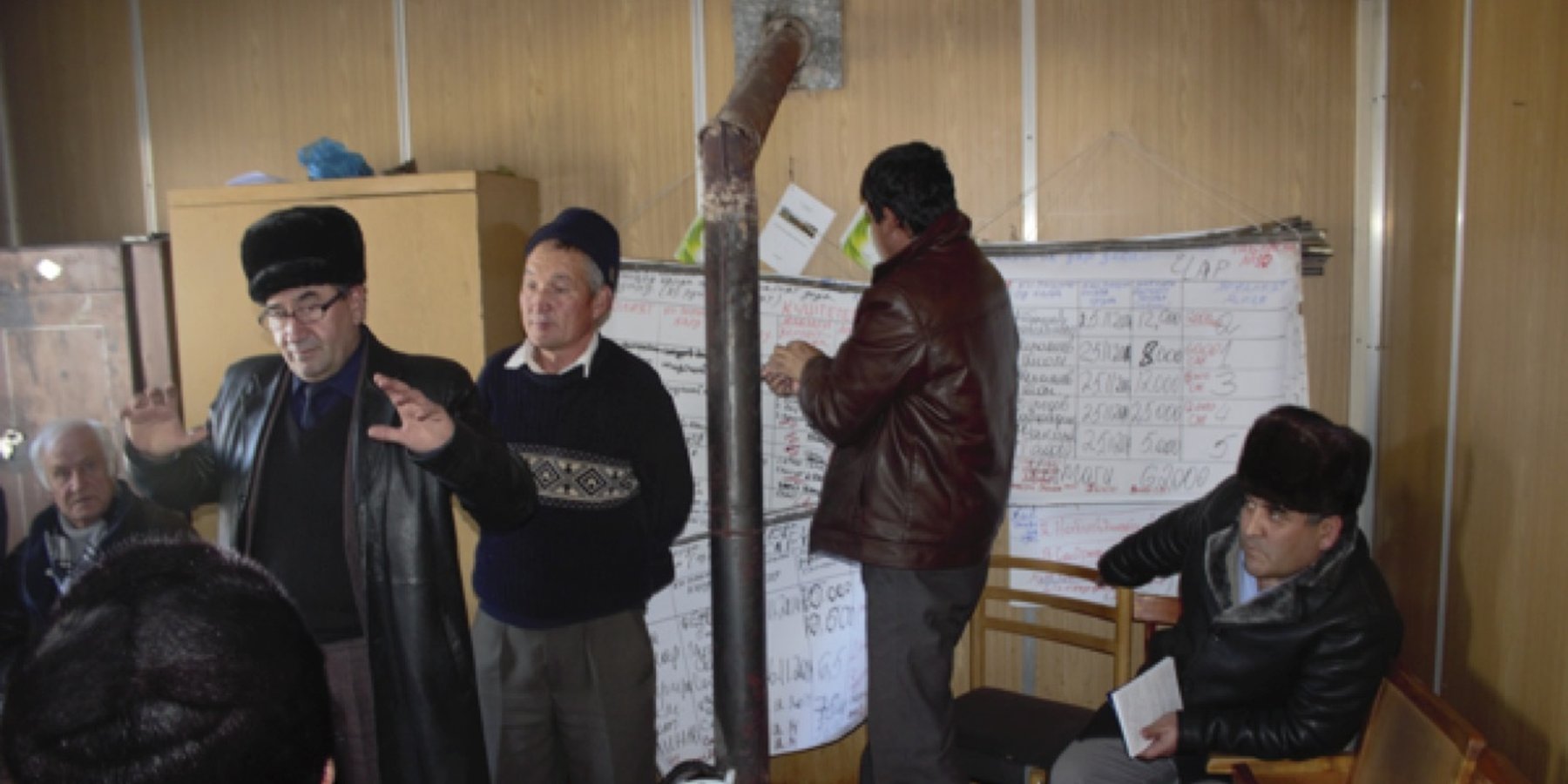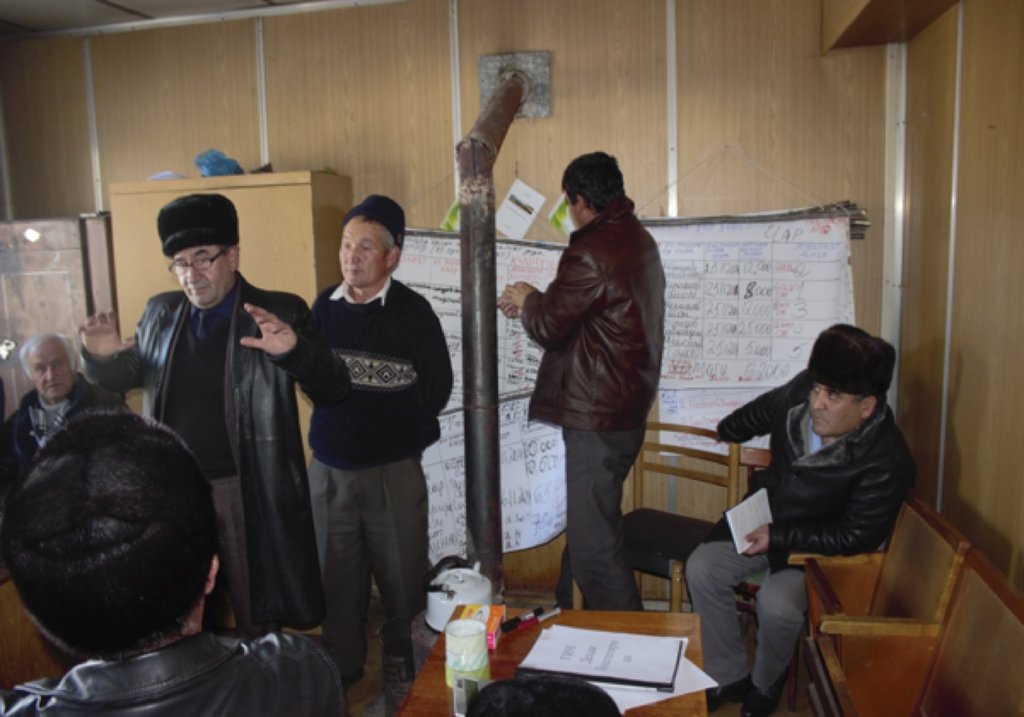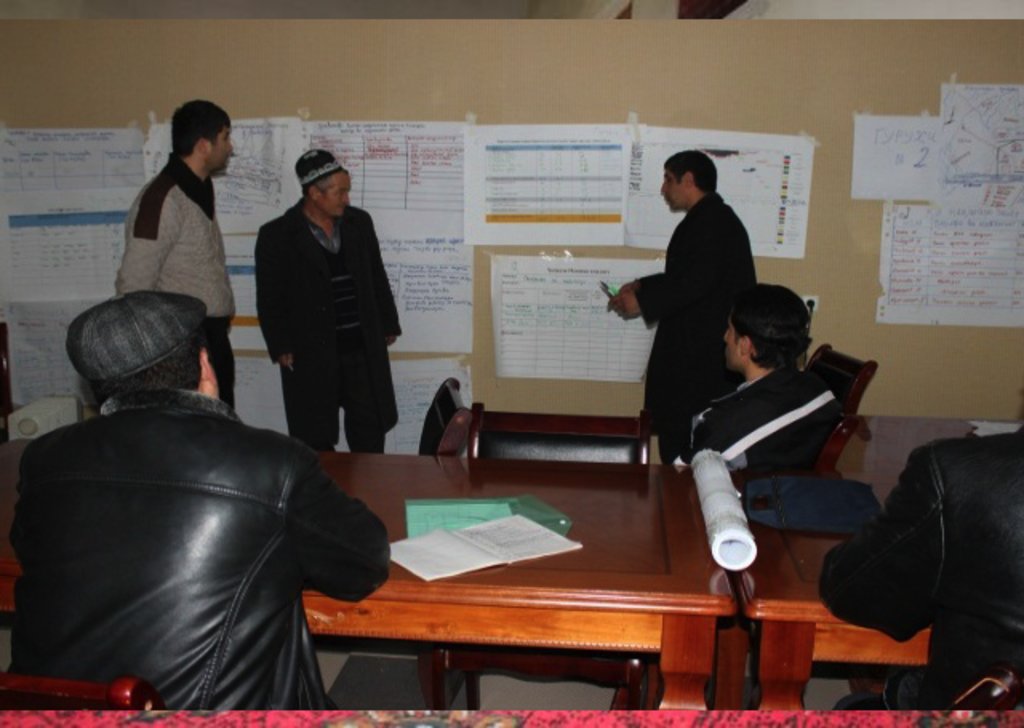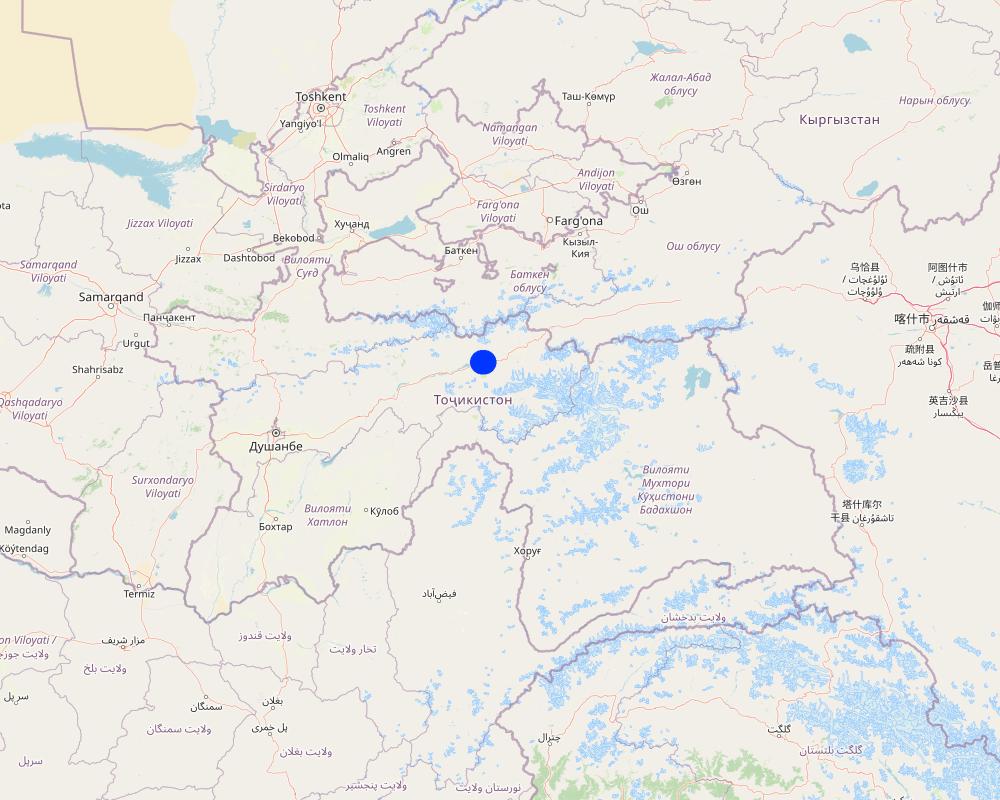Pasture and Livestock Management Plan [ຕາຈິກິສະຕານ]
- ການສ້າງ:
- ປັບປູງ:
- ຜູ້ສັງລວມຂໍ້ມູນ: Askarsho Zevarshoev
- ບັນນາທິການ: –
- ຜູ້ທົບທວນຄືນ: Yacime Khadraoui, Maximilian Knoll, Joana Eichenberger
Накшаи Идоракунии Чорво ва Чарогох
approaches_3459 - ຕາຈິກິສະຕານ
ເບິ່ງພາກສ່ວນ
ຂະຫຍາຍທັງໝົດ ຍຸບທັງໝົດ1. ຂໍ້ມູນທົ່ວໄປ
1.2 ລາຍລະອຽດ ການຕິດຕໍ່ ຂອງບຸກຄົນທີ່ຊັບພະຍາກອນ ແລະ ສະຖາບັນ ການມີສ່ວນຮ່ວມ ໃນການປະເມີນຜົນ ແລະ ເອກະສານ ຂອງວິທີທາງ
ຊື່ຂອງໂຄງການ ທີ່ອໍານວຍຄວາມສະດວກ ໃນການສ້າງເອກກະສານ ຫຼື ປະເມີນດ້ານແນວທາງ (ຖ້າກ່ຽວຂ້ອງ)
Environmental Land Management and Rural Livelihoods (ELMAR)ຊື່ຂອງ ສະຖາບັນການຈັດຕັ້ງ ທີ່ອໍານວຍຄວາມສະດວກ ໃນການສ້າງເອກກະສານ ຫຼື ປະເມີນແນວທາງ (ຖ້າກ່ຽວຂ້ອງ)
Aga Khan Foundation (AKF) - ສະວິດເຊີແລນ1.3 ເງື່ອນໄຂ ຂອງການນໍາໃຊ້ເອກກະສານຂໍ້ມູນ ຂອງ WOCAT
ເມື່ອໃດທີ່ໄດ້ສັງລວມຂໍ້ມູນ (ຢູ່ພາກສະໜາມ)?
15/07/2014
ຜູ້ສັງລວມ ແລະ ບັນດາຜູ້ຕອບແບບສອບຖາມ ຍອມຮັບໃນເງື່ອນໄຂ ການນໍາໃຊ້ຂໍ້ມູນເອກະສານ ທີ່ສ້າງຂື້ນ ໂດຍຜ່ານ ອົງການ WOCAT:
ແມ່ນ
1.4 ເອກະສານອ້າງອີງ (ຫຼາຍ) ກັບແບບສອບຖາມ (ຫຼາຍ) ເຕັກໂນໂລຢີ ຂອງດ້ານການຄຸ້ມຄອງ ດິນແບບຍືນຍົງ
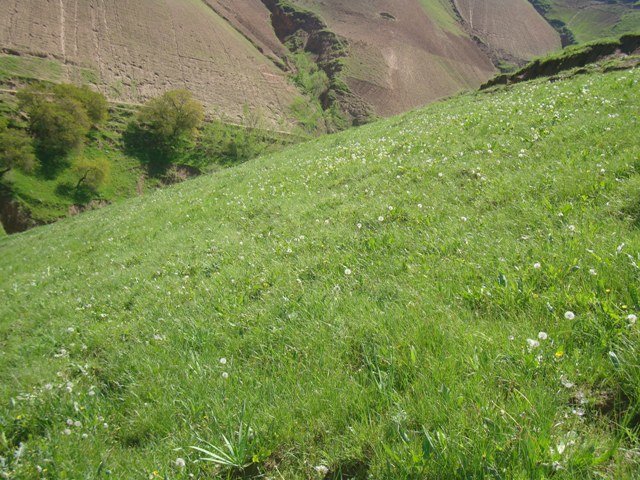
Rehabilitation of degraded pastures with alfalfa [ອັຟການີດສະຖານ]
Degraded pastures are restored with alfalfa through broad seeding method. The area is put under quarantine for three years to allow for the pasture to restore sufficiently.
- ຜູ້ສັງລວມຂໍ້ມູນ: Bettina Wolfgramm
2. ພັນລະນາ ແນວທາງການຄຸ້ມຄອງນໍາໃຊ້ດິນແບບຍືນຍົງ
2.1 ການອະທິບາຍ ໂດຍຫຍໍ້ ຂອງວິທີທາງ
"Pasture and Livestock Management Plan" is a participatory approach which is guiding pasture users, members of Pasture User Unions and Pasture User Groups to develop their action plan on pasture and livestock management. The approach brings together stakeholders, who are involved at any stage in pasture management or can contribute to or impede the implementation of the pasture livestock management plan.
2.2 ການອະທິບາຍ ລາຍລະອຽດ ຂອງວິທີທາງ
ການອະທິບາຍ ລາຍລະອຽດ ຂອງວິທີທາງ:
Pasture and Livestock Management Plan (PLMP) Approach is a participatory approach towards the development of a pasture plan with communities to ensure a sustainable use of pasture resources. It was especially designed for the needs of the Pasture User Union, a new structure allowed to establish at community level to implement better management of their pasture resources. Though a step-by-step analysis of the current situation a community will come up with detailed action plan for the following three years. The PLMP involves, but is not limited to, the establishment of a committee involved in preparation of the PLMP, as well as a stakeholder analysis and the determination of the carrying capacity of pasture resources by comparing the existing fodder resources and requirements for the fodder. Based on that analysis, an action plan will be developed with involvement of all stakeholders to reach an agreement on approaches and technologies to implement the interventions. The PLMP will lead to the development of the Action Plan based on the discussion between different stakeholders. In the process of the plan development with consideration of an expert a clear roles and responsibilities of all involved actors/stakeholder in a defined timeframe will be identified.
The main objectives is to support land users with development of actions, which contribute to the sustainable development of pasture resource and livestock development. The central focus is given to balance the need of the livestock owners to improve livestock productivity with compromising the environmental conditions for the next generations and ecosystem services. The planning process should contribute to better management of pasture lands, rehabilitation of degraded pastures, resolving any existing conflict over pasture use, awareness raising on the role of pasture land for ecosystem services and overall trends in development with regards to use and management of pasture resources.
The process is based on participatory methods with involvement of different stakeholders capturing main principles for land use planning. The process includes pasture users/livestock owners who are involved in day to day management of pasture lands, local government with related department to pasture use, land owners, different departments of local government such as forestry, land use committee, environmental protection etc.
The approach is conducted in three main stages: In the firs stage consultation with pasture users will be held to identify the need for development of a pasture plan. Then an inventory of all land resources, including pasture land and livestock numbers will be conducted. In the third stage a workshop will be conducted with involvement of all stakeholders, where the pasture plan will be developed. In the final stage of the pasture plan development an action plan with defined clear activities in a given frame and assigned responsible persons will be developed.
Land users, who also own livestock appreciate their involvement in the pasture development planning. They also like when their voice is taken into consideration in making any decision with regards to the pasture use.
2.3 ຮູບພາບຂອງແນວທາງ
ຂໍ້ສັງເກດໂດຍທົ່ວໄປກ່ຽວກັບການຮູບພາບ:
Participants reflecting on the overall process of the PLMP approach with all steps involved starting with setting up objectives and principles, analysis of stakeholders up to development of action plan.
2.5 ປະເທດ / ເຂດ / ສະຖານທີ່ບ່ອນທີ່ແນວທາງໄດ້ຖືກນໍາໃຊ້
ປະເທດ:
ຕາຈິກິສະຕານ
ພາກພື້ນ / ລັດ / ແຂວງ:
Rasht Valley/Lakhsh District
ຂໍ້ມູນເພີ່ມເຕີມຂອງສະຖານທີ່:
PUUs established in Rasht Valley under ELMARLP
Map
×2.6 ວັນທີເລີ່ມຕົ້ນ ແລະ ສິ້ນສຸດ ການຈັດຕັ້ງປະຕີບັດ ວິທີທາງ
ຖ້າຫາກບໍ່ຮູ້ຈັກປີທີ່ແນ່ນອນ, ໃຫ້ປະມານຄາດຄະເນ ເອົາມື້ທີ່ໄດ້ເລີ່ມຈັດຕັ້ງປະຕິບັດ ວິທີທາງ:
ຕໍ່າກວ່າ 10 ປີ ຜ່ານມາ (ມາເຖິງປະຈຸບັນ)
2.7 ປະເພດຂອງແນວທາງ
- ພາຍໃຕ້ໂຄງການ / ແຜນງານ
2.8 ເປົ້າໝາຍ / ຈຸດປະສົງຫຼັກ ຂອງການຈັດຕັ້ງປະຕິບັດ ວິທີທາງ
The main objective is to support land users with the development of actions, that contribute to the sustainable development of pasture resource and livestock development. The central focus is to balance the need of the livestock owners to improve livestock productivity without compromising the environmental conditions for next generations and ecosystem services. The planning process should contribute to better management of pasture lands, rehabilitation of degraded pastures, resolving any existing conflicts over pasture use, raise awareness on the role of pasture land for ecosystem services and overall trends in development with regards to use and management of pasture resources.
2.9 ເງື່ອນໄຂອໍານວຍ ຫຼື ຂັດຂວາງການປະຕິບັດຂອງເຕັກໂນໂລຢີ / ເຕັກໂນໂລຢີການນໍາໃຊ້ຕາມແນວທາງ
ສັງຄົມ / ວັດທະນະທໍາ / ມາດຕະຖານ ແລະ ຄຸນຄ່າທາງສາສະໜາ
- ເຊື່ອງຊ້ອນ
Communities are used to an ad hoc use of natural resources and therefore sometime not willing to structured planning processes in terms of use of pasture resources.
ມີຄວາມສາມາດ / ເຂັ້າເຖິງຊັບພະຍາກອນດ້ານການເງິນ ແລະ ການບໍລິການ
- ເຊື່ອງຊ້ອນ
In the case that funding is not available from project side, it may hinder further implementation of the actions planned under the PLMP approach.
ການກໍ່ຕັ້ງສະຖາບັນ
- ອໍານວຍ
The PLMP approach is specifically designed for the PUU, which are legally registered institutes under the governmental law. This enables the process to run continously.
ການຮ່ວມມື / ການປະສານງານຂອງຜູ້ກ່ຽວຂ້ອງ
- ອໍານວຍ
Depending on the leadership of the institutional structure, if well managed, it can enable collaboration among different stakeholders
- ເຊື່ອງຊ້ອນ
The newly established PUUs do not have enough power to influence the institutes in which stakeholders who are not interested in the sustainable use of pasture resources work hinder the planning process.
ກ່ຽວກັບກົດໝາຍ (ສິດນໍາໃຊ້ດິນ, ສິດນໍາໃຊ້ນໍ້າ)
- ອໍານວຍ
mainly used by the PUUs, which are are functioning in the framework of state law
ນະໂຍບາຍ
- ອໍານວຍ
The plan is developed for the Pasture User Unions, which are legal structure responsible for pasture management at community level.
ການປົກຄອງທີ່ດິນ (ການຕັດສິນໃຈ, ການປະຕິບັດ ແລະ ຂໍ້ບັງຄັບ)
- ອໍານວຍ
The approach will enable community members (PUUs) to become legal owners of the pasture resources according to the Pasture Law of the Republic of Tajikistan.
ຄວາມຮູ້ກ່ຽວກັບການຄຸ້ມຄອງ ທີ່ດິນແບບຍືນຍົງ, ການເຂົ້າເຖິງການສະໜັບສະໜູນ ທາງດ້ານວິຊາການ
- ອໍານວຍ
Experts in the field are supported technically by project consultants, several trainings on the process and approach are conducted for them.
3. ການມີສ່ວນຮ່ວມ ແລະ ບົດບາດຂອງພາກສ່ວນທີ່ກ່ຽວຂ້ອງທີ່ໄດ້ມີສ່ວນຮ່ວມ
3.1 ຜູ້ມີສ່ວນຮ່ວມ ໃນວິທີທາງ ແລະ ພາລະບົດບາດ ຂອງເຂົາເຈົ້າ
- ຜູ້ນໍາໃຊ້ດິນໃນທ້ອງຖິ່ນ / ຊຸມຊົນທ້ອງຖິ່ນ
livestock owners and PUU members
involved in direct process development and implementation of the approach
- ອົງການຈັດຕັ້ງ ພາຍໃນຊຸມຊົນ
village organizations, pasture user unions
also registered in the framework of the state law and are represented in the PUU. mainly involved in mobilization of the community to participate in the development and implementation of the plan
- ຜູ້ຊ່ຽວຊານ ການນຄຸ້ມຄອງ ທີ່ດິນແບບຍືນຍົງ / ທີ່ປຶກສາດ້ານກະສິກໍາ
project consultants and technical staff
facilitate the process of developing the PLMP approach, capacity building on the approach for the members of PUU
- ອົງການຈັດຕັ້ງ ທີ່ບໍ່ຂື້ນກັບລັດຖະບານ
locally registered public organizations which are directly involved in the natural resource and environmental management
provide technical support to the community and land users; can also support with fundraising
- ພາກເອກະຊົນ
entrepreneurs at local level
co-funding of the implementation of some of the practices from the PLMP
- ອໍານາດ ການປົກຄອງທ້ອງຖິ່ນ
local level government (sub-district authority), land use committee, committee of environmental protection, agriculture department etc.,
as one of the main stakeholders responsible for management of natural resource; can also provide overall supervision of the approach development; PUUs for which the PLMP is developed: legal structure under the Pasture Law of the Republic of Tajikistan.
ຖ້າຫາກມີຫຼາຍພາກສ່ວນທີ່ເຂົ້າຮ່ວມ ໃຫ້ລະບຸ ອົງການທີ່ເປັນຫຼັກ ໃນການຈັດຕັ້ງປະຕິບັດ:
Land Commttee
3.2 ການມີສ່ວນຮ່ວມຂອງຜູ້ນໍາໃຊ້ທີ່ດິນໃນທ້ອງຖິ່ນ / ຊຸມຊົນທ້ອງຖິ່ນໃນໄລຍະທີ່ແຕກຕ່າງກັນຂອງແນວທາງ
| ການລວບລວມ ເອົາຜູ້ນໍາໃຊ້ດິນ ໃນທ້ອງຖິ່ນ / ຊຸມຊົນທ້ອງຖິ່ນ | ໃຫ້ລະບຸ ຜູ້ໃດທີ່ມີສ່ວນຮ່ວມ ໃນແຕ່ລະກິດຈະກໍາ? | |
|---|---|---|
| ການເລີ່ມຕົ້ນ / ແຮງຈູງໃຈ | ການຊ່ວຍເຫຼືອຈາກພາຍນອກ | livestock owners, PUU members; consultation with livestock owners, facilitation the process of establishment of PUUs |
| ການວາງແຜນ | ການຮ່ວມມື | land users, PUU members, pasture experts |
| ການປະຕິບັດ | ການຮ່ວມມື | PUU members and expert from project; consultation with stakeholders, conduct workshop and development of the plan |
| ຕິດຕາມກວດກາ / ການປະເມີນຜົນ | ການຊ່ວຍເຫຼືອຈາກພາຍນອກ | from project team and management of PUU |
3.4 ການຕັດສິນໃຈກ່ຽວກັບການຄັດເລືອກເຕັກໂນໂລຢີຂອງການຄຸ້ມຄອງທີ່ດິນແບບຍືນຍົງ / ເຕັກໂນໂລຢີ
ລະບຸ ຄົນທີ່ຕັດສິນໃຈ ກ່ຽວກັບການຄັດເລືອກຂອງ ເຕັກໂນໂລຢີ / ເຕັກໂນໂລຢີ ຈະໄດ້ຮັບການປະຕິບັດ:
- ຜູ້ຊ່ຽວຊານ ຫຼັກດ້ານການຄຸ້ມຄອງ ທີ່ດິນແບບຍືນຍົງ, ມີການຕິດຕາມປຶກສາຫາລືກັບຜູ້ນໍາໃຊ້ທີ່ດິນ
ອະທິບາຍ:
Mainly as a new approach, best practices from the WOCAT database were used by the SLM specialists to introduce to land users and traditional practices were also applied based on the knowledge of land users.
Specify on what basis decisions were made:
- ປະເມີນເອກກະສານ ຄວາມຮູ້ກ່ຽວກັບ ການຄຸ້ມຄອງ ທີ່ດິນແບບຍືນຍົງ (ຫຼັກຖານທີ່ຊ່ວຍໃນການຕັດສິນໃຈ)
- ປະສົບການສ່ວນບຸກຄົນ ແລະ ຄວາມຄິດເຫັນ (ທີ່ບໍ່ເປັນເອກກະສານ)
4. ການສະໜັບສະໜູນທາງດ້ານວິຊາການ, ການສ້າງຄວາມສາມາດ, ແລະ ການຈັດການຄວາມຮູ້.
4.1 ການສ້າງຄວາມສາມາດ / ການຝຶກອົບຮົມ
ຜູ້ນໍາໃຊ້ທີ່ດິນ ຫຼື ພາກສ່ວນກ່ຽວຂ້ອງອື່ນໆ ໄດ້ຮັບການຝຶກອົບຮົມບໍ່?
ແມ່ນ
ໃຫ້ລະບຸ ຜູ້ໃດທີ່ໄດ້ຮັບການຝຶກອົບຮົມ:
- ຜູ້ນໍາໃຊ້ດິນ
- ພະນັກງານພາກສະໜາມ / ທີ່ປຶກສາ
ຮູບແບບຂອງການຝຶກອົບຮົມ:
- ການເຮັດຕົວຈິງ
- ກອງປະຊຸມ
ໃນຫົວຂໍ້:
"Pasture and Livestock Management Plan" methodology, proposal development for fund raising, Environmental Land Management
4.2 ການບໍລິການໃຫ້ຄໍາປຶກສາ
ເຮັດຜູ້ໃຊ້ທີ່ດິນມີການເຂົ້າເຖິງການບໍລິການໃຫ້ຄໍາປຶກສາ?
ແມ່ນ
ລະບຸວ່າການສະໜອງ ການບໍລິການ ໃຫ້ຄໍາປຶກສາ:
- ໃນພື້ນທີ່ຂອງຜູ້ນໍາໃຊ້ດິນ
ອະທິບາຍ / ຄວາມຄິດເຫັນ:
During the project period continuos visits were organized to the project site to review the progress and provide advisory service. The project implmentation team consisting of different experts, including pasture, environmental specialists and monitoring and evaluation experts.
4.3 ສະຖາບັນການສ້າງຄວາມເຂັ້ມແຂງ (ການພັດທະນາອົງການຈັດຕັ້ງ)
ສະຖາບັນ ໄດ້ຮັບການສ້າງຕັ້ງຂື້ນ ຫຼື ໄດ້ຮັບການສ້າງຄວາມເຂັ້ມແຂງ ໂດຍການຈັດຕັ້ງປະຕິບັດ ວິທີທາງບໍ່?
- ມີ, ຫຼາຍ
ລະບຸ ທາງສະຖາບັນ ໄດ້ສ້າງຄວາມເຂັ້ມແຂງ ໃນລະດັບໃດ (ຫຼາຍ):
- ທ້ອງຖິ່ນ
ອະທິບາຍ ສະຖາບັນການຈັດຕັ້ງ, ພາລະບົດບາດ ແລະ ໜ້າທີ່ຮັບຜິດຊອບ, ສະມາຊິກ ແລະ ອື່ນໆ.
Pasture User Union was established at sub-district level.
ລະບຸ ປະເພດ ຂອງສະໜັບສະໜູນ:
- ທາງດ້ານການເງິນ
- ການສ້າງຄວາມອາດສາມາດ / ການຝຶກອົບຮົມ
ໃຫ້ລາຍລະອຽດເພີ່ມເຕີມ:
Different technical and administrative trainings were provided and the PUU was funded with certain amount for implementation of the PLMP approach.
4.4 ຕິດຕາມກວດກາ ແລະ ປະເມີນຜົນ
ການຈັດຕັ້ງປະຕິບັດ ວິທີທາງ ໄດ້ມີການປະເມີນຜົນ ແລະ ຕິດຕາມບໍ?
ແມ່ນ
ຄວາມຄິດເຫັນ:
The final section of the PLMP is monitoring and evaluation. At each stage a responsible person among the stakeholders is assigned to conduct the plan implementation. In addition, the project team also conducts monitoring of the approach.
ຖ້າແມ່ນ, ເອກກະສານສະບັບນີ້ ແມ່ນໄດ້ນໍາໃຊ້ເຂົ້າໃນການຕິດຕາມ ແລະ ປະເມີນຜົນບໍ່?
ແມ່ນ
ຄວາມຄິດເຫັນ:
The implementing agency has a monitoring methodology, which will be used by the project team to conduct monitoring.
4.5 ການຄົ້ນຄວ້າ
ນີ້້ແມ່ນສ່ວນໜຶ່ງ ການຄົ້ນຄວ້າ ຂອງວິທີທາງບໍ່?
ບໍ່ແມ່ນ
5. ການສະໜັບສະໜູນທາງດ້ານການເງິນ ແລະ ອຸປະກອນຈາກພາຍນອກ
5.1 ງົບປະມານປະຈໍາປີ ສໍາລັບວິທີທາງ ຂອງການຄຸ້ມຄອງ ທີ່ດິນແບບຍືນຍົງ
ຖ້າຫາກບໍ່ຮູ້ຈັດງົບປະມານທີ່ແນ່ນອນ ແມ່ນໃຫ້ປະມານເອົາ:
- 2,000-10,000
ຄໍາເຫັນ (ຕົວຢ່າງ: ແຫຼ່ງຂໍ້ມູນຫຼັກ ຂອງການສະໜອງທຶນ / ຜູ້ໃຫ້ທຶນທີ່ສໍາຄັນ):
World Bank in the framework of ELMARL - Environmental Land Management and Rural Livelihood project
5.2 ການສະໜັບສະໜູນ ທາງດ້ານການເງິນ / ອຸປະກອນ ສະໜອງໃຫ້ແກ່ຜູ້ນໍາທີ່ດິນ
ຜູ້ນໍາໃຊ້ດິນ ໄດ້ຮັບການສະໜັບສະໜູນ ທາງດ້ານ ການເງິນ / ອຸປະກອນ ໃນການຈັດຕັ້ງປະຕິບັດ ເຕັກໂນໂລຢີບໍ?
ບໍ່ແມ່ນ
5.3 ເງິນສົມທົບສໍາລັບການນໍາໃຊ້ສະເພາະປັດໃຈຂາເຂົ້າໃນການຜະລີດກະສິກໍາ (ລວມທັງແຮງງານ)
- ບໍ່ມີ
ຖ້າແຮງງານ ຂອງຜູ້ນໍາໃຊ້ດິນ ໄດ້ຮັບການສະໜັບສະໜູນ ປັດໃຈຂາເຂົ້າ, ແມ່ນບໍ່:
- ການອາສາ
ຄວາມຄິດເຫັນ:
This is traditional now and any project fund should be accompanied by contributions from communities, which is mainly labour on a voluntary basis
5.4 ສິນເຊື່ອ
ໄດ້ປ່ອຍສິນເຊື່ອ ສະໜອງໃຫ້ພາຍໃຕ້ ວິທີການສໍາລັບກິດຈະກໍາ ການຄຸ້ມຄອງ ທີ່ດິນແບບຍືນນຍົງບໍ່?
ບໍ່ແມ່ນ
5.5 ສິ່ງຈູງໃຈ ຫຼື ເຄື່ອງມືອື່ນໆ
ການສົ່ງເສີມ ຈັດຕັ້ງປະຕິບັດ ເຕັກໂນໂລຢີ ໃນການຄຸ້ມຄອງ ດິນແບບຍືນຍົງ ໄດ້ສະໜອງສິ່ງກະຕຸກຊຸກຍູ້ບໍ່?
ບໍ່ແມ່ນ
6. ວິເຄາະຜົນກະທົບ ແລະ ສັງລວມບັນຫາ
6.1 ຜົນກະທົບຂອງແນວທາງ
ວິທີທາງ ຊ່ວຍຊຸກຍູ້ ຜູ້ນຳໃຊ້ທີ່ດິນທ້ອງຖີ່ນ, ໃນການປັບປຸງ ການມີສ່ວນຮ່ວມ ຂອງຜູ້ທີ່ກ່ຽວຂ້ອງ ບໍ່?
- ບໍ່
- ມີ, ໜ້ອຍໜຶ່ງ
- ມີ, ພໍສົມຄວນ
- ມີ, ຫຼາຍ
It directly helped them to identify their status and understand their right to land use.
ການຈັດຕັ້ງປະຕິບັດ ວິທີທາງ ສາມາດຊ່ວຍຜູ້ນໍາໃຊ້ທີ່ດິນ ໃນການຈັດຕັ້ງປະຕິບັດ ແລະ ບໍາລຸງຮັກສາ ເຕັກໂນໂລຢີ ການຄຸ້ມຄອງ ທີ່ດິນແບບຍືນຍົງໄດ້ບໍ?
- ບໍ່
- ມີ, ໜ້ອຍໜຶ່ງ
- ມີ, ພໍສົມຄວນ
- ມີ, ຫຼາຍ
All technologies planned under the approach as part of their action plan were later financed by projects to implement.
after development of the pasture and livestock management plan the PUUs were supported financial from the ELMARL project to implement the plan
the plan is developed through conducted workshop with participation of all stakeholders, including land users, where they get opportunity to learn experiences of other stakeholders.
All stakeholders involved in the process including women and youth had an opportunity to make decisions in line with other stakeholders.
ການນໍາໃຊ້ ວິທີທາງ ສາມາດຫຼຸດຜ່ອນ ຂໍ້ຂັດແຍ່ງໄດ້ບໍ່?
- ບໍ່
- ມີ, ໜ້ອຍໜຶ່ງ
- ມີ, ພໍສົມຄວນ
- ມີ, ຫຼາຍ
Roles and responsibilities identified all stakeholder and one of the objective to mitigate conflict brought under discussion conflict over pasture use and tried to solve it to some extent.
ການຈັດຕັ້ງປະຕິບັດ ວິທີທາງ ສາມາດສ້າງຄວາມເຂັ້ມແຂງ ທາງສັງຄົມ ແລະ ເສດຖະກິດບໍ່?
- ບໍ່
- ມີ, ໜ້ອຍໜຶ່ງ
- ມີ, ພໍສົມຄວນ
- ມີ, ຫຼາຍ
Women's role in livestock management was identified and empowered.
All stakeholders involved in the process including women and youth had an opportunity to make decisions in line with other stakeholders.
the approach give the land users/PUU members rights to become owner of the pasture under the Pasture Law of the Republic of Tajikistan
6.2 ແຮງຈູງໃຈຫຼັກຂອງຜູ້ນໍາໃຊ້ທີ່ດິນໃນການປະຕິບັດການຄຸ້ມຄອງທີ່ດິນແບບຍືນຍົງ
- ການຜະລິດເພີ່ມຂຶ້ນ
- ຫຼຸດຜ່ອນດິນເຊື່ອມໂຊມ
The rotation plan for rehabilitation of degraded pasture is applied.
- ຫຼຸດຜ່ອນຄວາມສ່ຽງຂອງໄພພິບັດ
Watershed approach was applied to ban grazing in some areas to prevent land slide and mudflow as a result of degradation.
- ກົດລະບຽບແລະລະບຽບການ (ລະອຽດ) / ການບັງຄັບໃຊ້
The plan does not set certain rules at this stage to enforce the regulation, but the community is planning to negotiate and set certain rules in case of not following the regulations to implement the plan.
6.3 ຄວາມຍືນຍົງຂອງກິດຈະກໍາວິທີທາງ
ຜູ້ນໍາໃຊ້ ທີ່ດິນ ສາມາດສືບຕໍ່ ການຈັດຕັ້ງປະຕິບັດ ຜ່ານວິທີທາງໄດ້ບໍ່ (ໂດຍປາດສະຈາກ ການຊ່ວຍເຫຼືອ ຈາກພາກສ່ວນພາຍນອກ)?
- ບໍ່ແນ່ນອນ
ຖ້າ ບໍ່ ຫຼື ບໍ່ແນ່ໃຈ, ໃຫ້ອະທິບາຍ ແລະ ຄໍາເຫັນ:
depends on the availability of funding, leadership and support from other stakeholders, especially local government
6.4 ຈຸດແຂງ / ຂໍ້ດີ ຂອງວິທີທາງ
| ຈຸດແຂງ / ຂໍ້ດີ / ໂອກາດໃນການນໍາໃຊ້ທີ່ດິນ |
|---|
| active participation in the development of the plan |
| better understanding of the current situation with regards to pasture use and importance of pasture plan development |
| ຈຸດແຂງ / ຈຸດດີ / ໂອກາດ ຈາກທັດສະນະຂອງຜູ້ປ້ອນຂໍ້ມູນ ຫຼື ບຸກຄົນສຳຄັນ |
|---|
| involvement of all stakeholders, especially land users and taking their knowledge and voice into consideration in decision making |
| building of the knowledge and opening a platform for collaboration between different stakeholders interested in sustainable management of pasture resources |
6.5 ຈຸດອ່ອນ / ຂໍ້ເສຍຂອງແນວທາງ ແລະ ວິທີການແກ້ໄຂໃຫ້ເຂົາເຈົ້າ
| ຈຸດອ່ອນ / ຂໍ້ເສຍ / ຄວາມສ່ຽງໃນມູມມອງຂອງຜູ້ນໍາໃຊ້ທີ່ດິນ | ມີວິທີການແກ້ໄຂຄືແນວໃດ? |
|---|---|
| time consuming, requires resource in the short term | should be understand as a means of livelihoods and spend more time, improve understanding of better gain in a long term |
| ຈຸດອ່ອນ ຫຼື ຂໍ້ເສຍ ຫຼື ຄວາມສ່ຽງ ໃນມຸມມອງຂອງ ຜູ້ສັງລວມຂໍ້ມູນ ຫຼື ບັນດາຜູ້ຕອບແບບສອບຖາມ | ມີວິທີການແກ້ໄຂຄືແນວໃດ? |
|---|---|
| financial resources | should design longer term project to attract funding before the approach becomes self sustained |
| low capacity of the stakeholders, | more trainings, sharing of experiences |
| human resources | More focus should be given to younger generation to build their capacity and involve them in the approach development |
7. ເອກກະສານອ້າງອີງ ແລະ ຂໍ້ມູນການເຊື່ອມໂຍງ
7.1 ວິທີການ / ແຫຼ່ງຂໍ້ມູນ
- ການໄປຢ້ຽມຢາມພາກສະໜາມ, ການສໍາຫຼວດພາກສະໜາມ
6
- ການສໍາພາດ ຜູ້ນໍາໃຊ້ທີ່ດິນ
more than 50
- ສໍາພາດ ຊ່ຽວຊານ ການຄຸ້ມຄອງ ດິນແບບຍືນຍົງ
5
- ການລວບລວມ ບົດລາຍງານ ແລະ ເອກະສານອື່ນໆ ທີ່ມີຢູ່ແລ້ວ
3
7.2 ເອກະສານທົ່ວໄປທີ່ສາມາດໃຊ້ໄດ້
ຫົວຂໍ້, ຜູ້ຂຽນ, ປີ, ISBN:
Pasture and Livestock Management Plan Manual
ມີຢູ່ໃສ?ມູນຄ່າເທົ່າໃດ?
Available upon request
7.3 ການເຊື່ອມຕໍ່ກັບຂໍ້ມູນທີ່ກ່ຽວຂ້ອງທີ່ສາມາດໃຊ້ອອນໄລນ໌
ຫົວຂໍ້ / ພັນລະນາ:
Pasture Management Networking Platform (PMNP)
URL:
https://pasture.klink.asia/dms/documents/groups/796?page=2
ຂໍ້ມູນການເຊື່ອມຕໍ່ ແລະ ເນື້ອໃນ
ຂະຫຍາຍທັງໝົດ ຍຸບທັງໝົດການເຊື່ອມຕໍ່

Rehabilitation of degraded pastures with alfalfa [ອັຟການີດສະຖານ]
Degraded pastures are restored with alfalfa through broad seeding method. The area is put under quarantine for three years to allow for the pasture to restore sufficiently.
- ຜູ້ສັງລວມຂໍ້ມູນ: Bettina Wolfgramm
ເນື້ອໃນ
ບໍ່ມີເນື້ອໃນ


